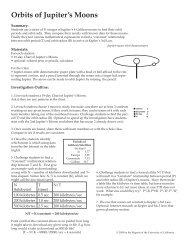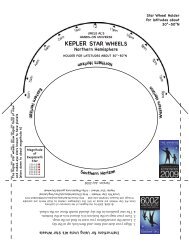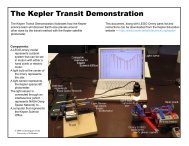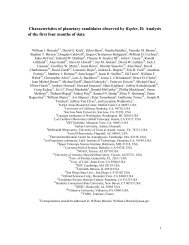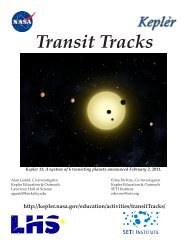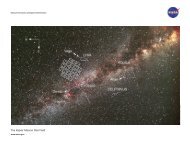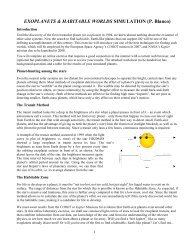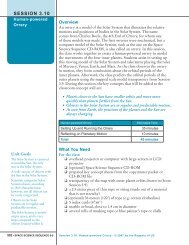Poster Abstracts - Kepler - NASA
Poster Abstracts - Kepler - NASA
Poster Abstracts - Kepler - NASA
- No tags were found...
Create successful ePaper yourself
Turn your PDF publications into a flip-book with our unique Google optimized e-Paper software.
POSTER ABSTRACTSP1013. POSTER SESSION IIScience from <strong>Kepler</strong> Collateral Data: 50 ksec/year from 13 million stars. J. J. Kolodziejczak 1 and D. A.Caldwell 2 , 1 Space Science Office, <strong>NASA</strong> Marshall Space Flight Center, Huntsville, AL 35812; kolodz@nasa.gov,2 SETI Institute, <strong>NASA</strong> Ames Research Center; Douglas.Caldwell@nasa.gov.Introduction: As each <strong>Kepler</strong> frame is read outunshuttered, light from each star in a CCD columnaccumulates in successive pixels as they wait for thenext row to be read out. This accumulation is the samein the masked rows at the start of the readout and virtualrows at the end of the readout as it is in the sciencedata. A range of these "smear" rows are added togetherfor each long cadence and sent to the ground for calibrationpurposes. We will introduce and describe thissmear collateral data, discuss and demonstrate its potentialuse for scientific studies exclusive of <strong>Kepler</strong>calibration,[1,2] including global characteristics ofstellar variability, which are influenced by parametersof galactic evolution.Photometric Precision: The smear data consists ofindividual column data for 24 rows, which represents a0.178% duty cycle or ~50 ksec of observing time / yearon every star in the <strong>Kepler</strong> field. This amounts to continuous1/2 hour sampling of all stars at a sensitivitylevel 1/23rd that of the regular science targets with thesignificant limitation that stars sharing the same CCDcolumn are summed.Applications: The smear data contain projectedinformation on zodiacal light and background, variablestars, variability of stellar populations. The figuresbelow show an example of background estimation, anda sample light curve including data from a bright variablestar during Q0-Q8 from the sky group cyclingthrough Ch. 7.3, 17.3, 19.3, and 9.3 during Q1-Q4,respectively. Additional examples will be show alongwith discussion of the necessary steps required to analyzethis unique data set, methods for accounting forimage artifacts[3], and peculiar limitations arising fromthe short exposures and projected nature of the data.References: [1] J. M. Jenkins, et al. (2010) ApJ,713, L87. [2] D. A. Caldwell et al. (2010) ApJ, 713,L92. [3] J. J. Kolodziejczak. (2010) Proc. SPIE, 7742,38.2162011 <strong>Kepler</strong> Science Conference - <strong>NASA</strong> Ames Research Center



